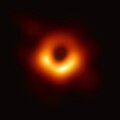
A rogue black hole is a black hole that is not bound by any object's gravity, allowing them to float freely throughout the universe. Since black holes emit no light, the only ways to detect them are gravitational lensing or x-ray bursts that occur when they destroy an object. [2]
